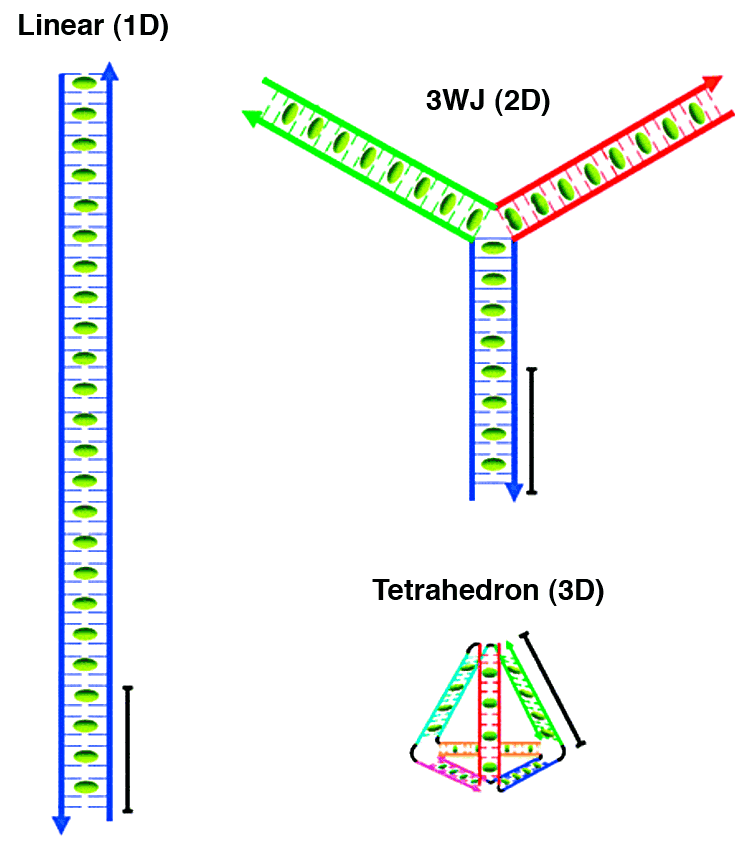Research
Project 2. Nanotags: Fluorescent DNA Nanostructures for Bioimaging and Sensing
The use of DNA as a construction material for nanoscale objects has passed from an initial exploratory phase into specific applications that leverage specific properties of the genetic material. In our lab, we are utilizing 2- and 3-D DNA nanostructures as scaffolds on which to assemble dozens of fluorescent intercalating dyes. The result is a fluorescent supramolecular object whose brightness greatly exceeds that of single fluorescent dyes. The bright fluorescence from these structures has led us to explore applications in fluorescent labeling and sensing, hence we refer to them as fluorescent DNA nanotags.
 The intercalating dyes can be bound to the DNA scaffold either through covalent or noncovalent interactions. The commercial availability of synthetic DNA and a variety of intercalating dyes allow off-the-shelf assembly of noncovalent nanotags by any lab. The intercalating dyes are available in a range of excitation and emission colors, providing great versatility in color choices. Meanwhile, energy transfer from the intercalating dyes to longer wavelength acceptor dyes that can be attached, for example, to the ends of the DNA strands, allows for efficient wavelength shifting and color multiplexing.
The intercalating dyes can be bound to the DNA scaffold either through covalent or noncovalent interactions. The commercial availability of synthetic DNA and a variety of intercalating dyes allow off-the-shelf assembly of noncovalent nanotags by any lab. The intercalating dyes are available in a range of excitation and emission colors, providing great versatility in color choices. Meanwhile, energy transfer from the intercalating dyes to longer wavelength acceptor dyes that can be attached, for example, to the ends of the DNA strands, allows for efficient wavelength shifting and color multiplexing.
Our earliest work in this area relied on 2-D nanostructures such as three-way junctions to provide scaffolds for the intercalating dyes.(1) However, our more recent work utilizes 3-D nanostructures such as tetrahedra, which are more compact than 2-D analogues having the same number of base pairs (and therefore intercalation sites).(2) Tetrahedra nanotags offer high photostability and resistance to nuclease digestion.
We have also demonstrated that DNA strands functionalized covalently with intercalating dyes can be conjugated to antibodies and then used for immunofluorescent staining within fixed Drosophila embryos.(3)
Current efforts in the lab are directed toward (a) further improving the brightness and stability of DNA nanotags and (b) applying DNA nanotags for the detection of specific protein or RNA targets.
Publications
- Benvin, A. L.; Creeger, Y.; Fisher, G. W.; Ballou, B.; Waggoner, A. S.; Armitage, B. A. “Fluorescent DNA Nanotags: Supramolecular Fluorescent Labels Based on Intercalating Dye Arrays Assembled on Nanostructured DNA Templates” J. Am. Chem. Soc. 2007, 129, 2025-2034.
- Özhalici-Ünal, H.; Armitage, B. A. “Fluorescent DNA Nanotags Based on a Self-Assembled DNA Tetrahedron” ACS Nano 2009, 3, 425-433.
- Stadler, A. L.; Delos Santos, J. O.; Stensrud, E. S.; Dembska, A.; Silva, G. L.; Liu, S.; Shank, N. I.; Kunttas-Tatli, E.; Sobers, C. J.; Gramlich, P. M. E.; Carell, T.; Peteanu, L. A.; McCartney, B. M.; Armitage, B. A. “Fluorescent DNA Nanotags Featuring Covalently Attached Intercalating Dyes: Synthesis, Antibody Conjugation and Intracellular Imaging” Bioconjugate Chem. 2011, 22, 1491-1502.

